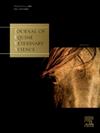野生金合欢提取物对马胞口蛋白的体内外抑制作用。
IF 1.6
3区 农林科学
Q2 VETERINARY SCIENCES
引用次数: 0
摘要
导言:驱虫虫的耐药性已经导致使用有机提取物作为寄生虫控制的替代方法。目的:研究金合欢提取物(单宁)在体外和体内对马胞口蛋白的控制作用。材料和方法:30匹天然感染cyathostomins的Pantaneiro马来自两个不同的农场,分别被指定为A农场和b农场。在研究开始时,所有的第三期幼虫都是cyathostomins,并使用两个农场马的粪便样本进行蛋孵化试验(EHT)。对粪卵计数减少试验(FECRT)进行了两项为期28天的随机现场研究,分别在第0、7、14、21和28天进行评估。第0天和第28天采集体重(BW)、体况评分(BCS),并采集血液进行血液学和生化分析。马饲粮为:马尾草、浓缩物1 kg、甘蔗液体糖蜜(对照)40 g、马尾草提取物25 g。结果:A场EC50值为13.2 mg/mL(95%可信区间[CI]: 11.8 ~ 14.7 mg/mL), B场EC50值为14.9 mg/mL(95%可信区间:13.3 ~ 16.9 mg/mL)。对照组与治疗组FECRT差异无统计学意义(P < 0.05),平均值分别为3.09和3.18。两组间血液及血液学指标差异无统计学意义(P < 0.05)。结论:单宁提取物在体外降低了卵的孵化率,但在体内试验中并未降低自然感染马的粪便卵数。本文章由计算机程序翻译,如有差异,请以英文原文为准。
In vitro and in vivo effects of Acacia mearnsii De Wild extract for cyathostomin control in horses
Introduction
Anthelmintic resistance has led to the use of organic extracts as alternative methods of parasite control.
Objectives
The study aimed to assess the effects of Acacia mearnsii extract (tannin) on the control of cyathostomins in horses, both in vitro and in vivo.
Materials and methods
Thirty Pantaneiro horses naturally infected with cyathostomins were sourced from two distinct farms, designated as Farms A and B. At the start of the study, all third-stage larvae were cyathostomins, and an egg hatchability test (EHT) was performed using fecal samples from horses on both farms. Two randomized 28-day field studies were conducted for the fecal egg count reduction test (FECRT) with evaluations on days 0, 7, 14, 21, and 28. On days 0 and 28, body weight (BW), body condition score (BCS), and blood samples for hematological and biochemical analysis were also collected. The horses diet included panicum grass pasture, 1 kg of concentrate, 40 g of liquid sugarcane molasses (Control), and 25 g of A. mearnsii extract.
Results
The EC50 values were 13.2 mg/mL (95 % confidence interval [CI]: 11.8–14.7 mg/mL) and 14.9 mg/mL (95 % CI: 13.3–16.9 mg/mL) for Farms A and B, respectively. The FECRT showed no effect (P > 0.05) between the control and treated groups, with mean values of 3.09% and 3.18%, respectively. Blood and hematological parameters also showed no differences (P > 0.05) between treatments.
Conclusion
The tannin extract reduced egg hatchability in vitro, but did not lower fecal egg counts in naturally infected horses during the in vivo trial.
求助全文
通过发布文献求助,成功后即可免费获取论文全文。
去求助
来源期刊

Journal of Equine Veterinary Science
农林科学-兽医学
CiteScore
2.70
自引率
7.70%
发文量
249
审稿时长
77 days
期刊介绍:
Journal of Equine Veterinary Science (JEVS) is an international publication designed for the practicing equine veterinarian, equine researcher, and other equine health care specialist. Published monthly, each issue of JEVS includes original research, reviews, case reports, short communications, and clinical techniques from leaders in the equine veterinary field, covering such topics as laminitis, reproduction, infectious disease, parasitology, behavior, podology, internal medicine, surgery and nutrition.
 求助内容:
求助内容: 应助结果提醒方式:
应助结果提醒方式:


